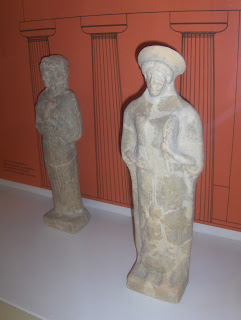Walking up the long, pine sheltered drive, past an impressive pair of pillared gate houses that seem to be
watched over by a scarcely interested caretaker, I asked a question
in Greek and was treated to a full and knowledgeable survey of Mon Repos' 250 acre
estate, nudging out over a slight promontory near Corfu town. I knew
of the place only distantly and had seen photos of it in disrepair in
the late 1990s. I was a little surprised then when I rounded the
final curve in the paved road and saw the building in reasonable repair, doors and shutters tightly
closed, several loud male voices evident from inside. I walked
round the entire building searching for the source of this spirited
discussion. Finally I tried a small door tucked in to the side of
the front entrance and... Chaotic but welcoming I was told there was
no admission fee and was free to wander around. I must admit to
being disappointed at not getting to come in through the front doors
to experience the hall's scale as I imagine the architect had
in mind for anyone entering the building, but I had the place
completely to myself apart from the attendants who moved around
the polished floors turning on lights for me as I glided through or when I wanted a photo of
the the lovely sweeping staircase.
 |
| A view to the sea from the portico |
Built on the ruins of St
Pandeleimon church, and believed to be the site of the ancient city
of Corfu, Mon Repos was first called The House of St Pandeleimon
then The Casino by Sir Frederick Adam and his Corfiot wife. The
regency style building was designed by architect Sir George Whitmore
who also designed the palace of St Michael and St George in Corfu
town. Sadly, the couple never enjoyed the palace as they were posted
to Madras as Governor. Unfortunately Adam, although well-loved by
the aristocrats on the island, left Corfu's coffers empty with his
extravagance. After cession of Corfu to Greece in 1864 the palace
was gifted to King George I of Greece and came to be known eventually
as Mon Repos. It is also known also as the birthplace of Prince
Philip, the Duke of Edinburgh, in 1921. After his birth the family
remained in residence for eighteen months until the political winds
of change overtook them in late 1922.
During the 1970s the
building fell into disrepair. Furnishings were sold, sent to other
houses and some disappeared, plundered. Being a hopeless romantic I
found the building beautiful in its shabby repose. Of course the
harsh climate would have turned it into a ruin eventually had its
refurbishment in the 1990s not occurred. (Note: dates listed are approximate as different sources state widely variable dates)
 |
| The rotunda lights the first floor hall and is supported by massive Ionic columns, reception rooms leading off it in all directions |
These days the building is The Paleopolis museum, probably in need again of a touch up here and there, as damp
is invading in many places. Each room is a gallery; containing
historical photos, documents, watercolours of the islands flora, artefacts from the various important archaeological sites both within the grounds and elsewhere on Corfu. It feels
institutional, with lighting in the cornice and period furniture dotted around the place, the obligatory audio visual tour
and displays, which admittedly are very informative. The interiors leave only a little sense of their former royal
and official occupants. But there are some wonderful ancient figures and other artefacts in the galleries, evocative photos of the island's more recent past. I've always admired too the reproduction quality of bits of sculpture and ancient jewellery,
not precious just a powerful reminder of an ancient past.
 |
| Miraculous BC survivor |
The building has a feeling
of being in transition, like many public buildings that have been
repurposed from private homes, and of course like many buildings in
Greece possibly earmarked for a firesale. I like to think of the
building full of life; the smell of beeswax polish, children laughing
and sliding down the banister in fancy clothes when the grown ups
aren't looking, mother making an entrance on the same staircase in a
somewhat more dignified manner, candles aglow, music in the
background, the scent of night flowers wafting in through thrown
open french doors. This should be a place for celebration.
 |
| The elegant staircase hall with pretty pink and white marble floor |
Instead it is only me,
dressed in humble linen, dreaming of a more glorious present for this
place, a place where judgement of the Greeks, from each other and in
the eyes of the world, is not afoot.




